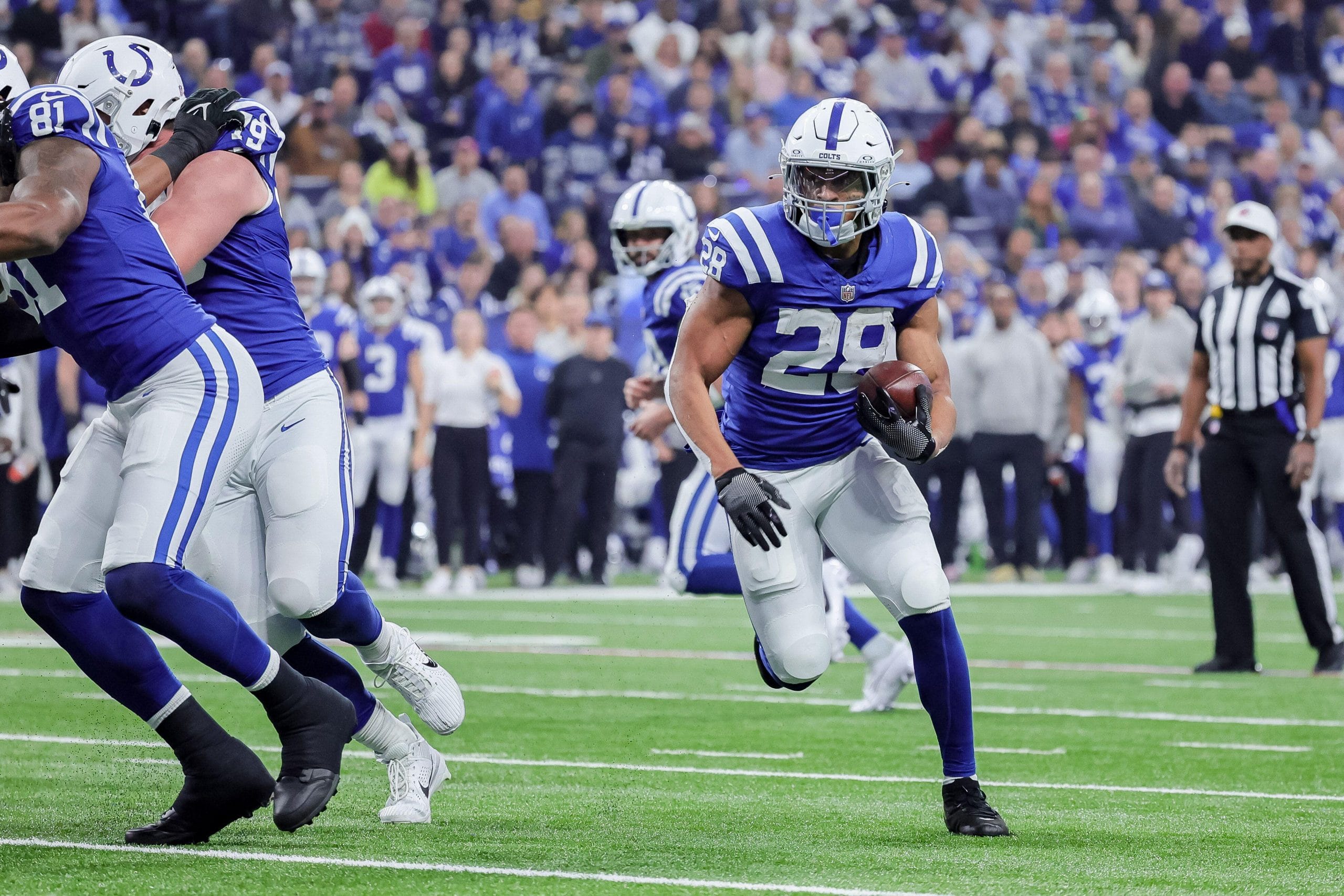
Quick Slant - 2025 Berlin Game: Better than a Corporate Retreat
Mat Irby’s Quick Slant
On May 9, 1945, the sun rose on Berlin. People woke to the sound of calm, turned the doorknob, and were met with a brisk spring morning—partly cloudy, 40 degrees Fahrenheit. They entered onto cobblestone streets, under a layer of ash, into a quiet clatter of stirring people surveying a sky, for once, without planes—their eardrums filled with an evasive serenity as familiar as childhood, but long written off as past. They walked among the bones of rotting cars lining cindered streets—the smell of damp soot rising to replace the stifling offense of smoke and fire that had long tormented the air. For the first time in years, tanks were not rolling, buildings were not crumbling; screams and sobs were replaced by quiet chatter. And as the people of Berlin took in fresh tranquility, it fell obliquely over the desperate backdrop of a city that had been utterly leveled.
Debris stacked up on either side of some streets like snowbanks that formed off the edge of a plow; others had been let go and more closely resembled city dumps. Buildings stood half erect, dilapidated like broken clay pots. Each windowless building whirred under a sharp breeze. Furniture—fabric and masonry torn and singed—lay strewn along urban corners like they had been thrown there by a god. And all of it blended to a grayish-brown monochrome beneath layers of mud and dust.
Then, someone picked up the first brick.
Few cities carry their scars as gracefully as Berlin. Even as the city has been reshaped in modernist tones—a process that took well over two decades—careful examination reveals select facades as patches applied to holes poked in a city once devastated. Today, however, as if restoration had become an addictive condition, Berlin is as clean as a modern metropolis can be. It is a global arts capital, a magnet for thought leaders, known for its strong pluralistic economy, leadership in green initiatives, and its diverse communal ethos.
Most of all, it is one of the world’s foremost symbols of redemption, reckoning, and rebuilding. It now stands as an icon for overcoming the insurmountable—rising again from the deepest depths of the most unimaginable oceanic desolation. If Berlin can do it, so can anyone.
In a way, it’s fitting that Berlin hosts Colts' QB Daniel Jones this weekend; in just two months, Jones has gone from being the most unremarkable, half-measure of an answer at QB this offseason to, at worst, a Cinderella story worth talking about at parties; at best, he’s the new Sam Darnold, or, dare I say it, Rich Gannon, and these are the first flutters of transcendence.
Week 9 proved there will still be bumps along the way, but Jones has been a key driving force behind one of the most potent offenses in football; to deny his culpability in that would be a grave disservice. But there is still work to be done.
The Colts—themselves rebuilt after a superstar’s sudden retirement and a miscalculation in drafting the QB of the future—find themselves at an inflection point. After a loss to Pittsburgh a week ago, there must be the creeping doubt of imposter syndrome—concern that they are actually a house of cards on the verge of collapse.
And standing at this crucial fulcrum, they find the plucky Falcons, who could better be analogized by a city like New York, where there is a duality within one being. As New York is at once ravaged by poverty, filth, and despair, and also an epicenter for wealth, status, and hope, the Falcons are at once a coin with two faces. This is the team that the Dolphins and Panthers embarrassed; this is also the team that upset the Bills in a fashion that left little doubt. The Falcons probably won’t march into January with this extreme volatility, but they have already proven they could pick off anyone on any day.
For the Colts, winning is already a matter of validation—a chance to prove that the reputation no one expected them to have two months ago is the real them; mounting failures will lead to overcompensation, and ultimately desperation. For the Falcons, at this point, this game is probably more in line with Tyler Durden’s glib excuse that nobody asked for, as he rolled off of Angel Face, mumbling: “I felt like destroying something beautiful.” For the Falcons, everything is about building culture, and knocking off a headliner is better than a corporate retreat.
Falcons
Implied Team Total: 21
The Colts are heavily favored at -6.5, and the combined over/under for the Colts and Falcons is 48.5, which is the second-highest number we see this week.
The Falcons are 24th in Pythagorean expected wins, based on points for and points against, which has them projected to finish with 6.7 wins. The Colts, on the other hand, rank second, on track for 12.2 wins. Obviously, a significant disparity is expected between these two teams.
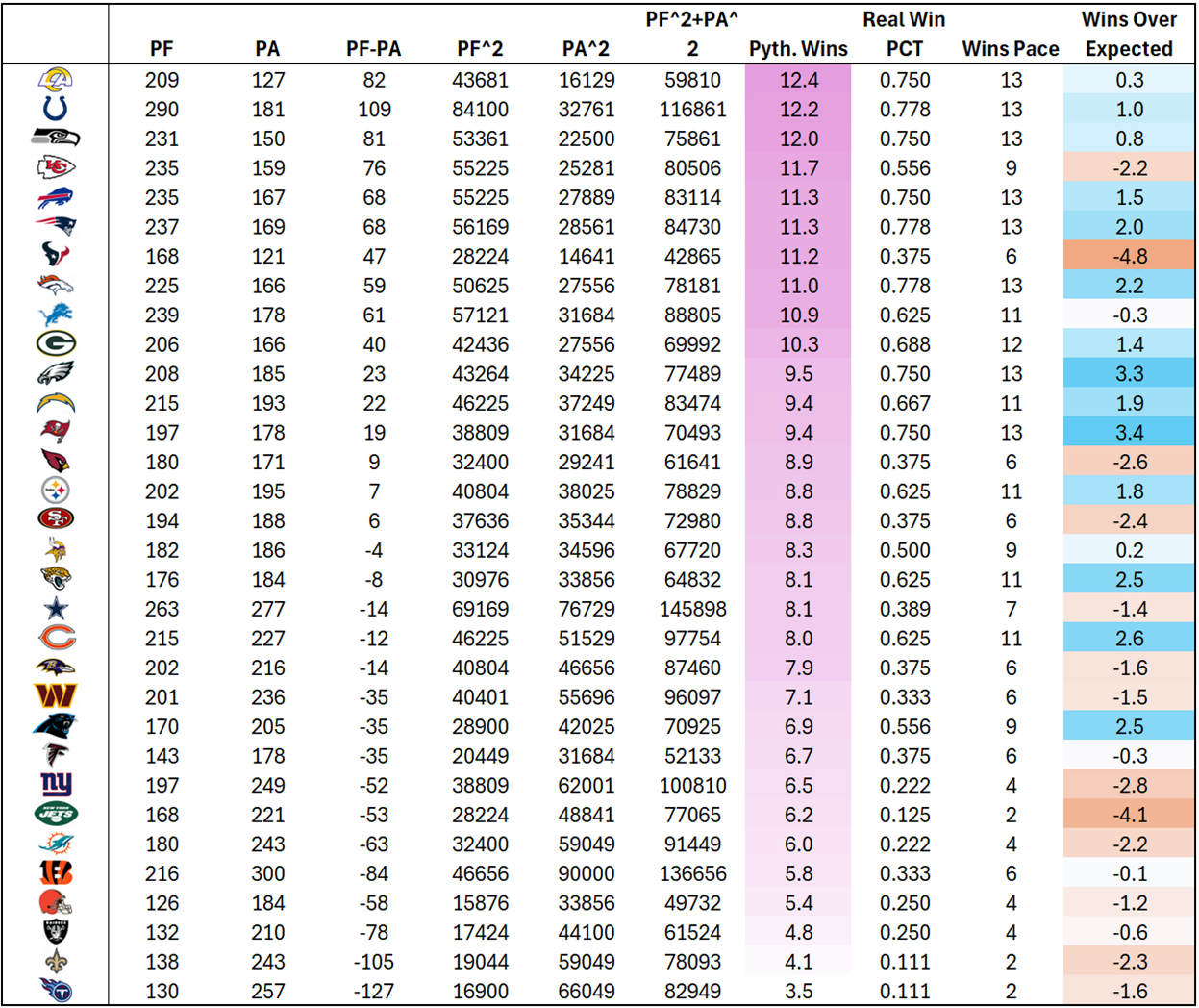
One of the most undervalued strategies in fantasy football is drafting from teams that have potent offenses and weak defenses. A team like Dallas, which exemplifies this dichotomy this year, is almost constantly engaged in a shootout. The worst combination, therefore, would be the inverse—a team like Cleveland, with a poor offense and a good defense. This is a recipe for lower-scoring games with fewer yards and fewer TDs.
On the scatterplot below, courtesy of rbsdm.com, I’ve highlighted in blue the section with teams that are below average offensively and above average defensively, and, though barely, the Falcons fit the bill.
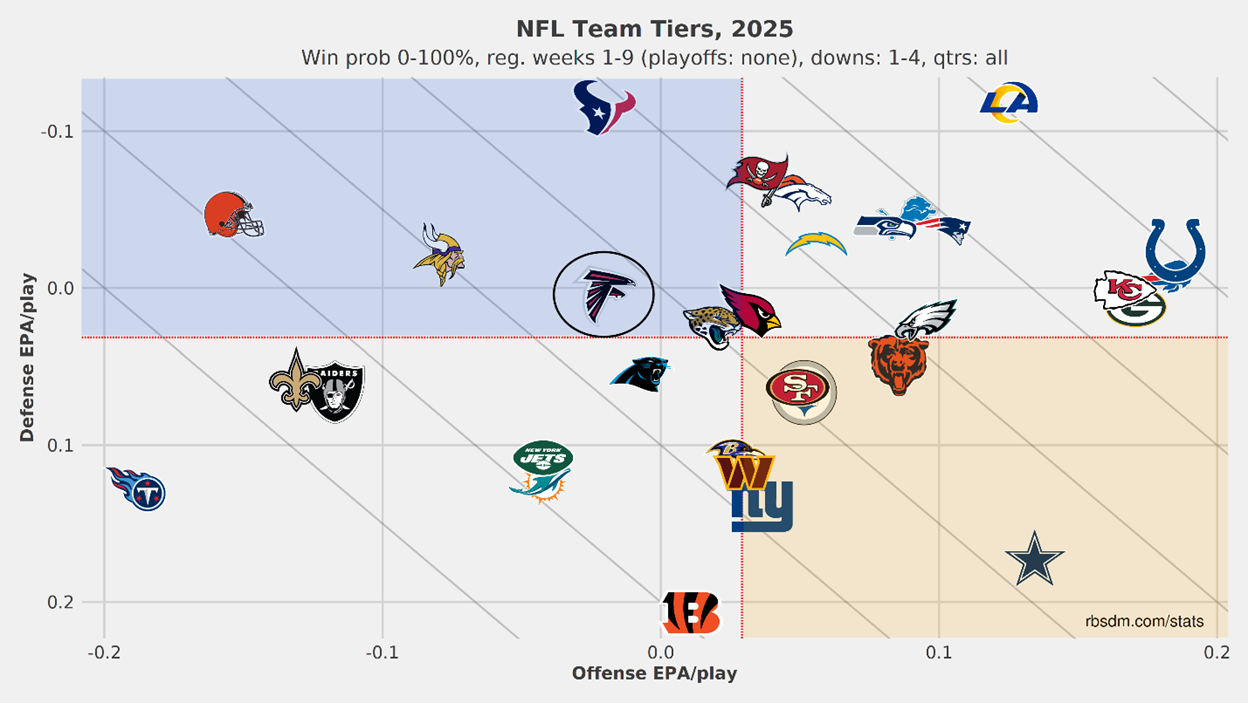
The Falcons are toward the middle in offensive pace, averaging 26.8 seconds to snap (14th). They also lie toward the middle of the league in pass/run splits with a pass rate of 58% (T-15th). They are trailing by seven points or more 33.5% of the time, which is above average. Their pass rate increases to 69% (9th) and their seconds to snap drop to 25.2 (12th) when trailing by as much. Because they spend an elevated number of plays in this mode, they appear pass-heavier than they intend to be. Their pass rate over expected (PROE) is -3.1% (22nd), so their heart’s desire is to run.
The Falcons are 25th in EPA per play and 21st in offensive success rate. They rank 22nd in EPA per dropback and 21st in offensive success rate on dropbacks.

They are led on offense by sophomore QB Michael Penix Jr. Penix has dropped back to pass 36.4 times per game (16th) and had 33.1 passing attempts per game (12th). His expected points per game (EP/G) is 17.4 (22nd), and his fantasy points over expected (FPOE) are -0.3 (28th). With 67 rushing yards so far, his rushing doesn’t provide him with a high platform. He is below average in both EPA and CPOE.
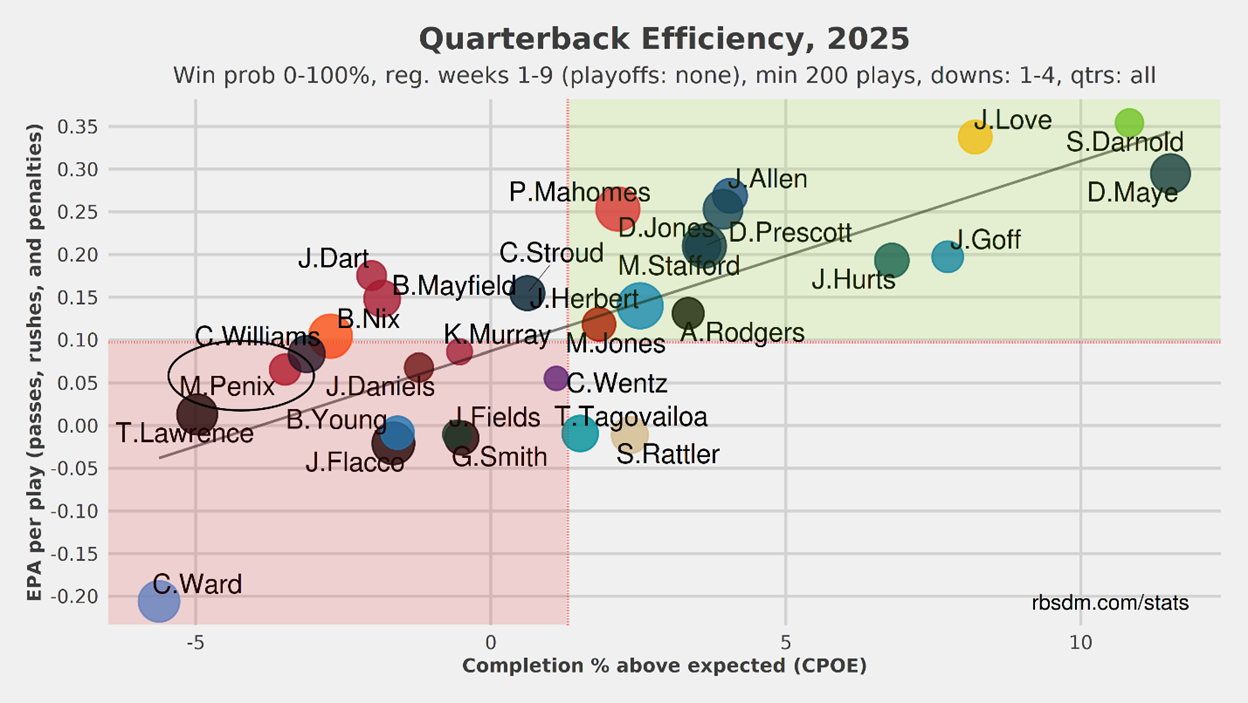
He has been a top 12 QB three times in eight games, although in each case, it was only barely. Including a rushing TD in Week 1, his three QB1 performances have come when he’s scored at least two TDs. He is a TD-dependent QB2.
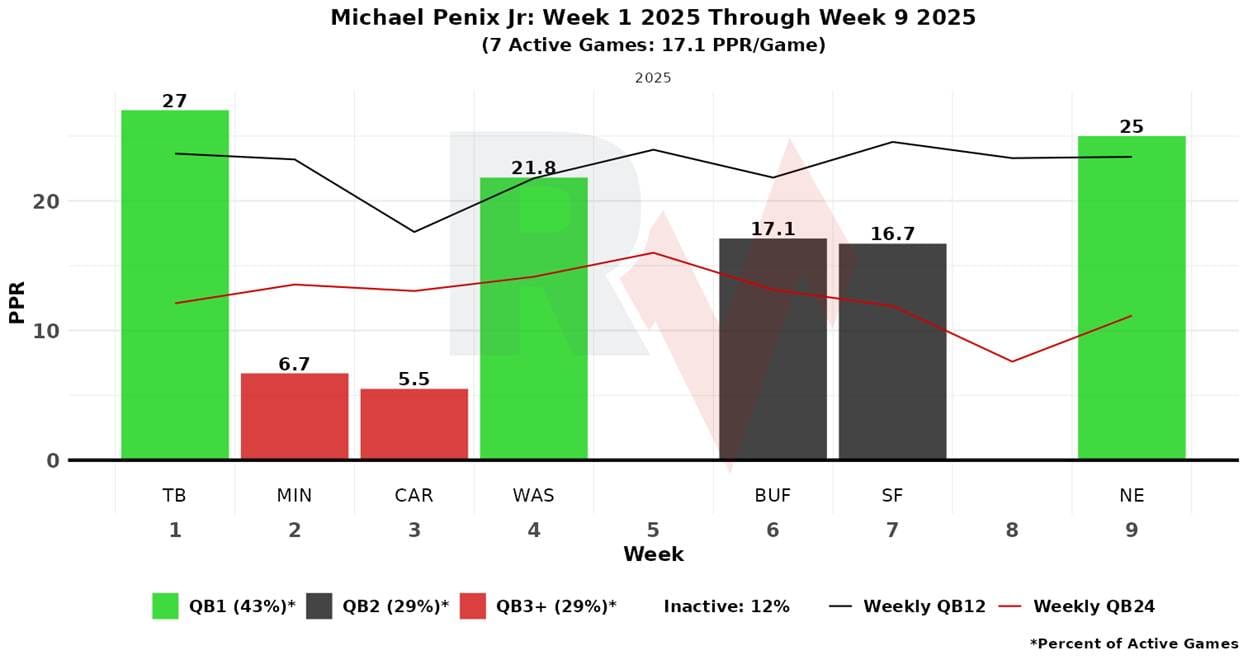
The Colts rank 10th in defensive EPA per play allowed and 21st in defensive success rate. This indicates they employ a “bend/don’t break” defense, vulnerable to long, sustained drives but effective at preventing those drives from resulting in scores, as well as limiting big plays.
This is supported by traditional data, which reveals that the Colts have allowed 20.7 points per game (7th) but have allowed 385.3 yards per game (31st). They rank ninth in EPA per dropback and 16th in defensive success rate on dropbacks. They made a blockbuster trade this week for Jets’ CB Sauce Gardner, which should improve their secondary. Having cleared concussion protocol on Thursday, Gardner should suit up right away.
The Colts have surrendered the 20th-most fantasy points to QBs in their last five games. Note the pattern that the points are coming from EP, where they’ve surrendered the second-most points, rather than FPOE, where they are best in the league. This reveals that the Colts have established leads early and have had teams chasing the points against them, forcing opponents to throw more, despite throwing being a less effective way of moving the ball. The Colts have faced 389 dropbacks, the most in the NFL.
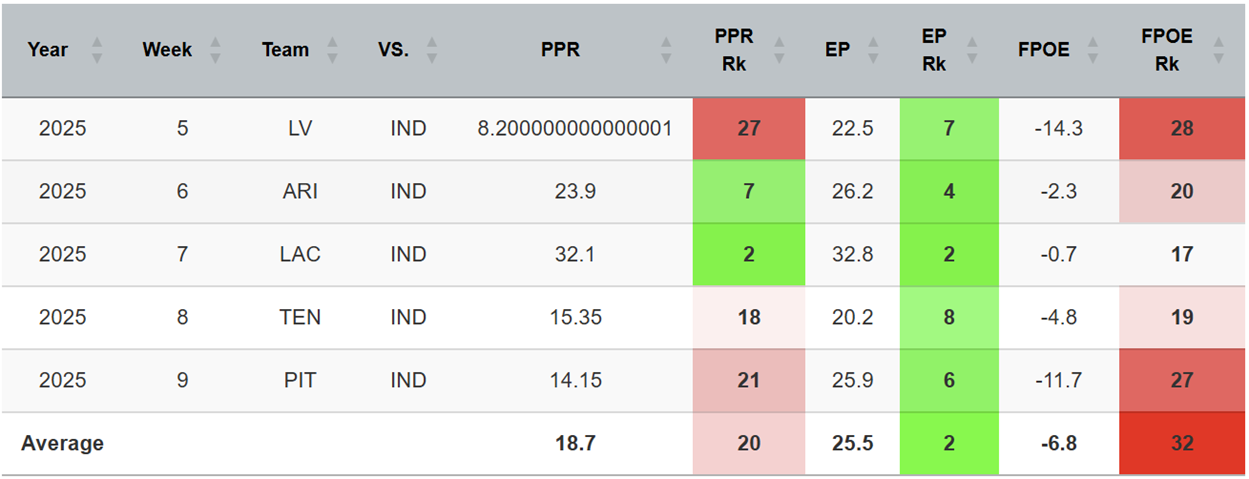
The Falcons have three players with target shares north of 15% in the last five games: WR Drake London (34.6%), TE Kyle Pitts (21.3%), and RB Bijan Robinson (20.1%). Each has an outstanding target share for their position; for the entire season, London ranks fourth in WR market share leaguewide, Pitts ranks third among TEs, and Robinson ranks third among RBs.

The Colts’ third-year CB Jaylon Jones was injured in Week 1 against Miami but returned last week, immediately taking on shadow coverage duties against DK Metcalf of the Steelers, and succeeding. This week, the team adds Gardner, PFF’s 22nd-ranked CB; he ranked first in 2022 and third in 2023. It stands to reason that, with these additions, the Colts’ secondary is stronger than it’s been—not just compared to their last five games against WRs, but across the entire season.
The Colts play man defense 26.7% of the time. They run single-high safety looks at a rate of 47.0%, and two-high looks at 53%. In zone alignments, the Colts allow 0.28 fantasy points/dropback (FP/DB, 30th), and in single-high, they allow 0.37 FP/DB (27th), so their best alignment, logically, is Cover 3. They use Cover 3 more than any other alignment (26.0%), followed by Cover 1 (20.1%). They are below average in terms of blitz frequency, blitzing at a rate of 22.9% (T-17th).
Fantasy Points’ coverage matchup tool assigns a zero-based matchup grade to each pass-catcher based on their opponent’s use of specific types and rates of coverage and how that pass-catcher performs against them. Positive numbers indicate a favorable matchup and negative numbers indicate an unfavorable one.
Based on the types and rates of coverage the Colts run, all of the Falcons’ pass-catchers have an almost entirely neutral matchup. Pitts’ matchup is the best at a +1% advantage according to the tool, but all WRs and TEs hover around zero, while Robinson’s coverage grade is at -12.2%.
PFF’s matchup tool is more player-based, considering which individuals a player is most likely to end up with on each play based on historical tendencies and comparing their PFF grades. In this model, London’s matchup draws a great designation, while Pitts and Penix grade out as good, and Robinson, as a receiver, grades out that way as well.
In their last five games, the Colts have been somewhat generous to fantasy WRs, especially against Arizona and the LA Chargers. They shut down the Steelers this last week upon Jones’ return. We again see the same pattern repeated, where their opponents’ EP (3rd) is well above their FPOE (32nd), indicating their opponents are attempting to win in the passing game, even as the passing game is yielding underwhelming results.

We shouldn’t be scared off of London based on these patterns because the bottom line is that the matchup has been mildly favorable in the aggregate. Whether production comes through efficiency or through volume as teams chase the Colts down, the fantasy production has been there. London is an outstanding player, and he is likely to get there, too. In his last four appearances, he hasn’t only been a top-12 WR three times; he’s been subatomic. Last week against New England (also a tough matchup on paper), he nearly stacked enough PPR points to have been a WR1 twice if you cut it in half.
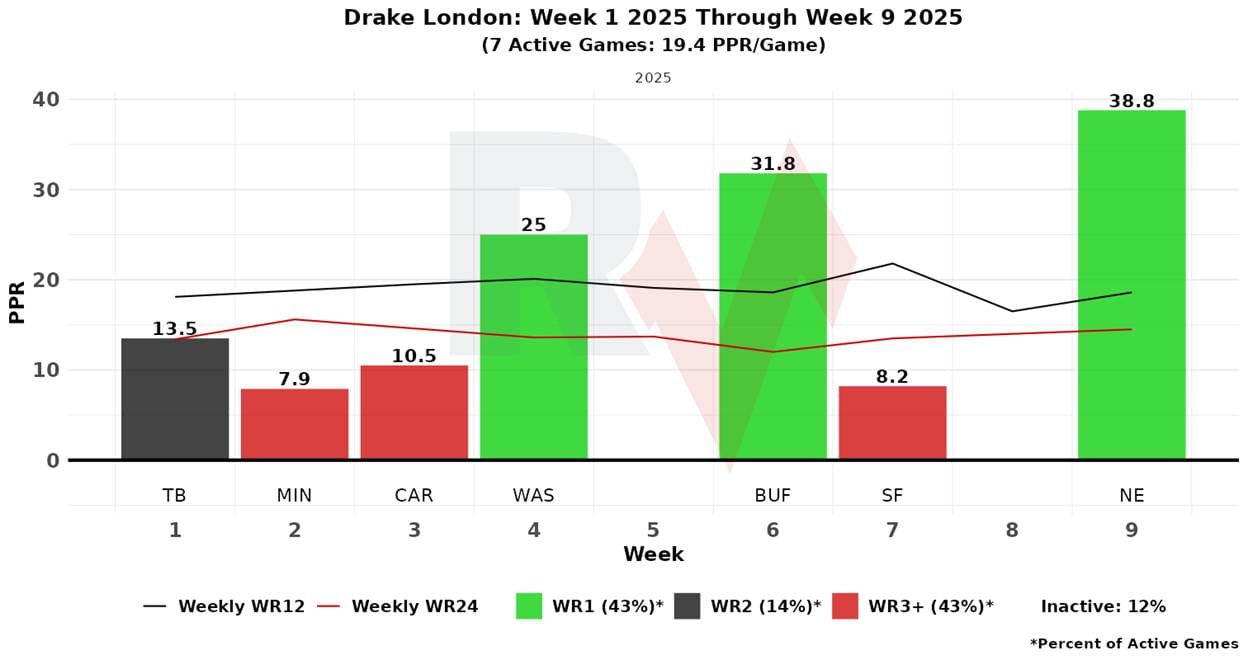
The Colts have been vulnerable to TEs, however, surrendering the third-most fantasy points to TEs in the last five weeks. It warrants investigation to note a contrast in the quality of the WRs and TEs that the Colts have faced during this stretch. The leading WRs in the games in which they played were: Tre Tucker, Zay Jones, Keenan Allen, Chimere Dike, and Calvin Austin. The leading TEs in those same games included Trey McBride and Orande Gadsden, who combined for 50.6 PPR points, almost exactly as many as Tucker, Jones, Dike, and Austin combined.

This bodes well for Pitts, who should be played pretty much everywhere.
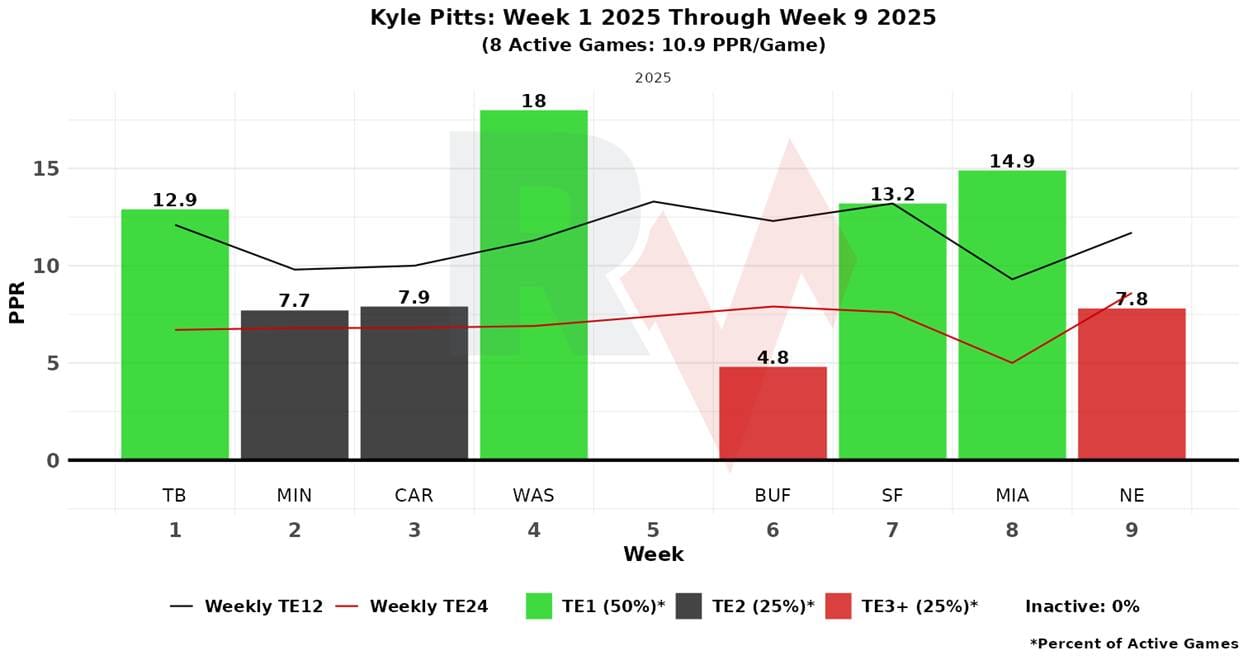
The Falcons’ offensive line is middling—generally capable, both as a pass-blocking and run-blocking unit. They have a +5.48% pressure rate over expected (PrROE, 13th on the week). The Colts’ pass rush, however, has been a slight weakness, generating only +1.43% PrROE (24th on the week). When composited, the Falcons’ pass-blocking unit has the sixth-best matchup of the week.
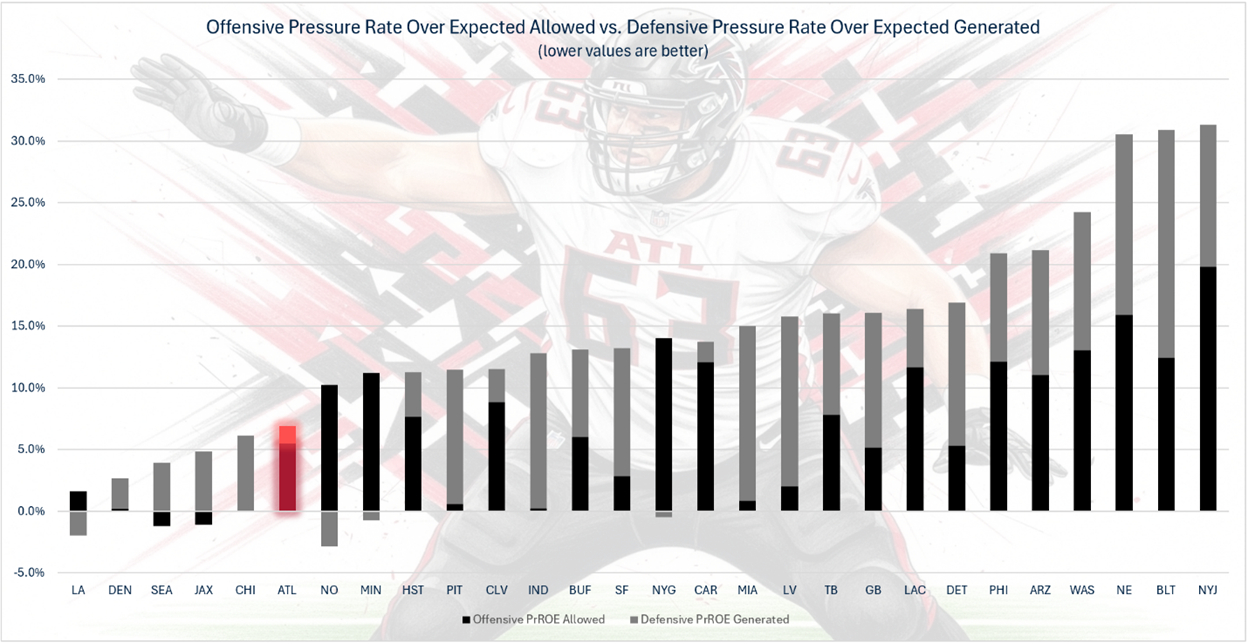
Based on a composite of Atlanta’s adjusted yards before contact per attempt (Adj YBC/Att) generated and the Colts’ Adj YBC/Att Allowed, the run blocking matchup is more neutral between Atlanta’s offense and Indianapolis’ defense.
RB Bijan Robinson is the unquestioned leader of the Falcons’ RB room, with a dominating 77% snap share, a 20% target share, and drawing 56% of team rush attempts.
RB Tyler Allgeier is still a pretty decent handcuff and should be rostered in most leagues. He even has appeal in heavy bye weeks as a standalone option, as he’s a decent threat to score TDs; he has four rushing scores (T-15th).

However, Robinson is, of course, one of the rare bell-cow type RBs fantasy managers crave—a throwback to a bygone era. Robinson is fifth in snap share and fourth in high-value touches (53).
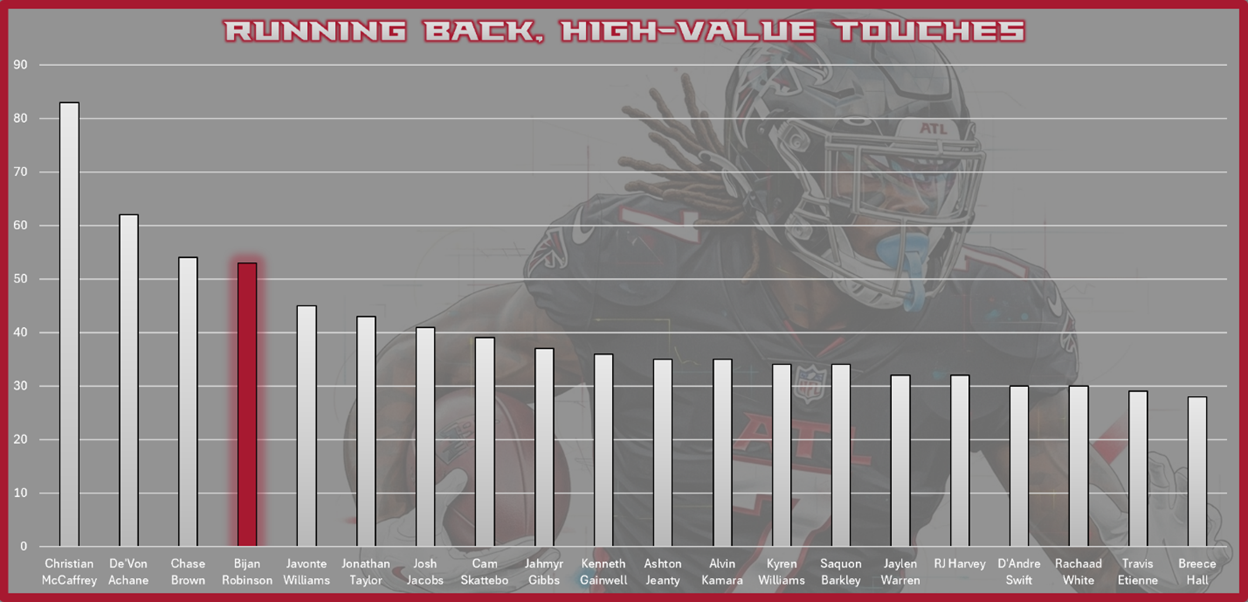
But the Falcons rank only 23rd in offensive EPA on rushes and 16th in offensive success rate on rushes. Part of this is Allgeier, who has -0.42 rush yards over expected (RYOE)/Att. Robinson is a net positive in efficiency, registering +0.57 RYOE/Att (T-19th) and a +8.6 rushing FPOE (15th).
Robinson has indeed been underwhelming running the ball, but so much of his overall production is owed to his receiving work. He ranks fifth in receiving FPOE (+17.8) and third in receiving EP (81.5), so he his getting both opportunity and efficiency through the air. Robinson has been an RB1 in PPR scoring every week but one.

The Colts rank 16th in defensive EPA per rush and 24th in defensive success rate on rushes.
They have been generally tough on fantasy RBs, surrendering the 21st-most points to RBs. Throughout that stretch, the closest thing to Robinson the Colts have seen is rookie Ashton Jeanty, who scored 15.9 PPR points.
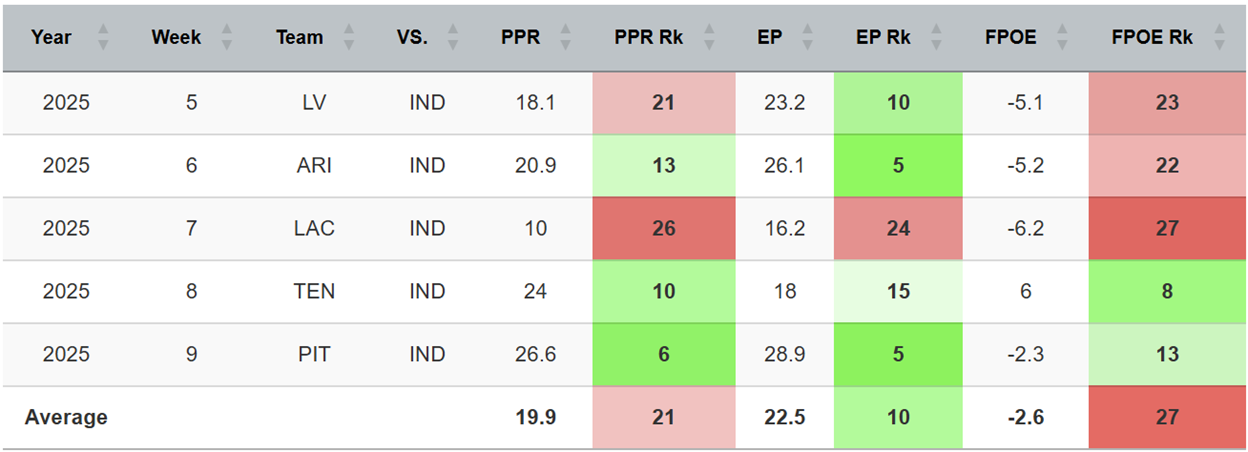
One area where they’ve been a little vulnerable in that stretch is in the passing game, as they’ve surrendered the 10th-most receiving yards to RBs and the 12th-most receptions to RBs during that span.
Robinson is always playable, but the Colts don’t strike me as an overly favorable or unfavorable matchup.
